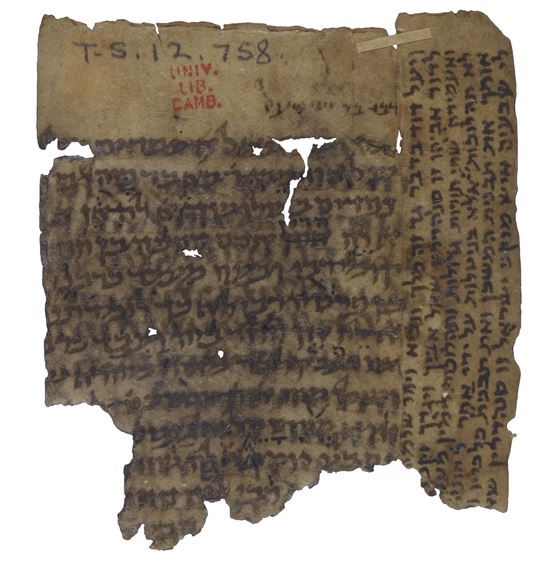The Book of Joshua in a Christian Palestinian Aramaic Palimpsest Fragment (T-S 12.758)

T-S 12.758 verso
For over 120 years, the verses of chapter 7:2c–4a; 9b–11a of the book of Joshua in the translation of Christian Palestinian Aramaic, a Western Aramaic dialect, remained unrecognized under the Palestinian Talmud tractate Sanhedrin 19a (40)–19b (37). It is a rather small parchment fragment (ca. 8 x 7 cm) with another even smaller fragment merged onto it on the right-hand side. This biblical text is a welcome addition to the transmission of the Bible in Christian Palestinian Aramaic, of which only scanty text remnants have survived. The only other witness of the book of Joshua is found on parchment, but not as a palimpsest: it comes from the Kastellion at Khirbet Mird (ca. 8th/9th century CE), a site nine kilometres northeast of Jerusalem, and is housed today in the Rockefeller Museum, Jerusalem.
Agnes Smith Lewis, who had edited a number of eleventh-century lectionaries (Gospel B, C; Lewis lectionary) in this dialect before, was entrusted by Solomon Schechter to publish the text in a monograph together with her sister Margaret Dunlop Gibson (Palestinian Syriac Texts from Palimpsest Fragments in the Taylor-Schechter Collection,1London, 1900). She, however, could not make out enough text and declared on p. 80 for this fragment XVII: ‘legi non potest’. This is not surprising as the neat script below – written in an early uncial type of Christian Palestinian Aramaic, in a modified Syriac Estrangela – is covered by small Hebrew letters that hide most of the underneath script. On account of the non-identification, the entries in several manuscript descriptions and attributions (e.g. Michael Sokoloff and Yoseph Yahalom, Christian Palimpsests from the Cairo Geniza, Revue d’Histoire des Textes 8,2 1987, 120) and catalogues of this dialect (e.g. Moshe Bar-Asher, Palestinian Syriac Studies. Source-Texts, Traditions and Grammatical Problems, Diss. Jerusalem, 1977 [Hebrew]) have a lacuna for this very text fragment.
With the help of an ultraviolet lamp and a dark room provided at the Cambridge University Library, this biblical text could be extracted from this fragmentary parchment folio. Reading and deciphering palimpsests is a challenge in itself and depends, for every individual case, often on the facilities provided but also, in addition to many other things, on a profound knowledge of the language the text is written in and a vague notion of what type of text might be hidden beneath.
This text fragment with the biblical passages of Joshua is a welcome addition to text-critical studies on the Septuagint. It should be pointed out that Christian Palestinian Aramaic translations are faithful witnesses to the Greek prototypes from which all texts were translated and can offer unattested textual variants of non-surviving Greek texts.
Footnotes
1 https://www.degruyter.com/document/doi/10.31826/9781463208493/html
2 https://www.persee.fr/doc/rht_0373-6075_1979_num_8_1978_1173
Cite this article
Müller-Kessler, Christa. 2023. "The Book of Joshua in a Christian Palestinian Aramaic Palimpsest Fragment (T-S 12.758)." Taylor-Schechter Genizah Research Unit. doi:10.17863/CAM.107305.
If you enjoyed this Fragment of the Month, you can find others here.
Contact us: genizah@lib.cam.ac.uk
The manuscripts in this article are part of the Cairo Genizah Collection in Cambridge University Library. To see more items from this collection visit: https://cudl.lib.cam.ac.uk/
